Organisational Success: HR Value and Contribution Report (Aldi Ltd)
VerifiedAdded on 2023/01/12
|12
|3651
|91
Report
AI Summary
This report explores the critical role of Human Resources (HR) in achieving organisational success, using Aldi Ltd. as a case study. It begins by evaluating the importance of organisational design theory, highlighting how effective structures enhance communication, productivity, and employee motivation. The report then analyzes various HR approaches and techniques, including content and process theories of motivation such as Maslow's Hierarchy of Needs and Herzberg's Two-Factor Theory, illustrating their impact on employee performance and engagement. Contemporary organizational structures like matrix and team structures are also examined. Furthermore, the report delves into the application of these theories and techniques within Aldi Ltd., providing practical insights into how HR can drive sustainable organisational success. The report also covers the different approaches and techniques used by human resources and provides contemporary knowledge to support emerging HR.
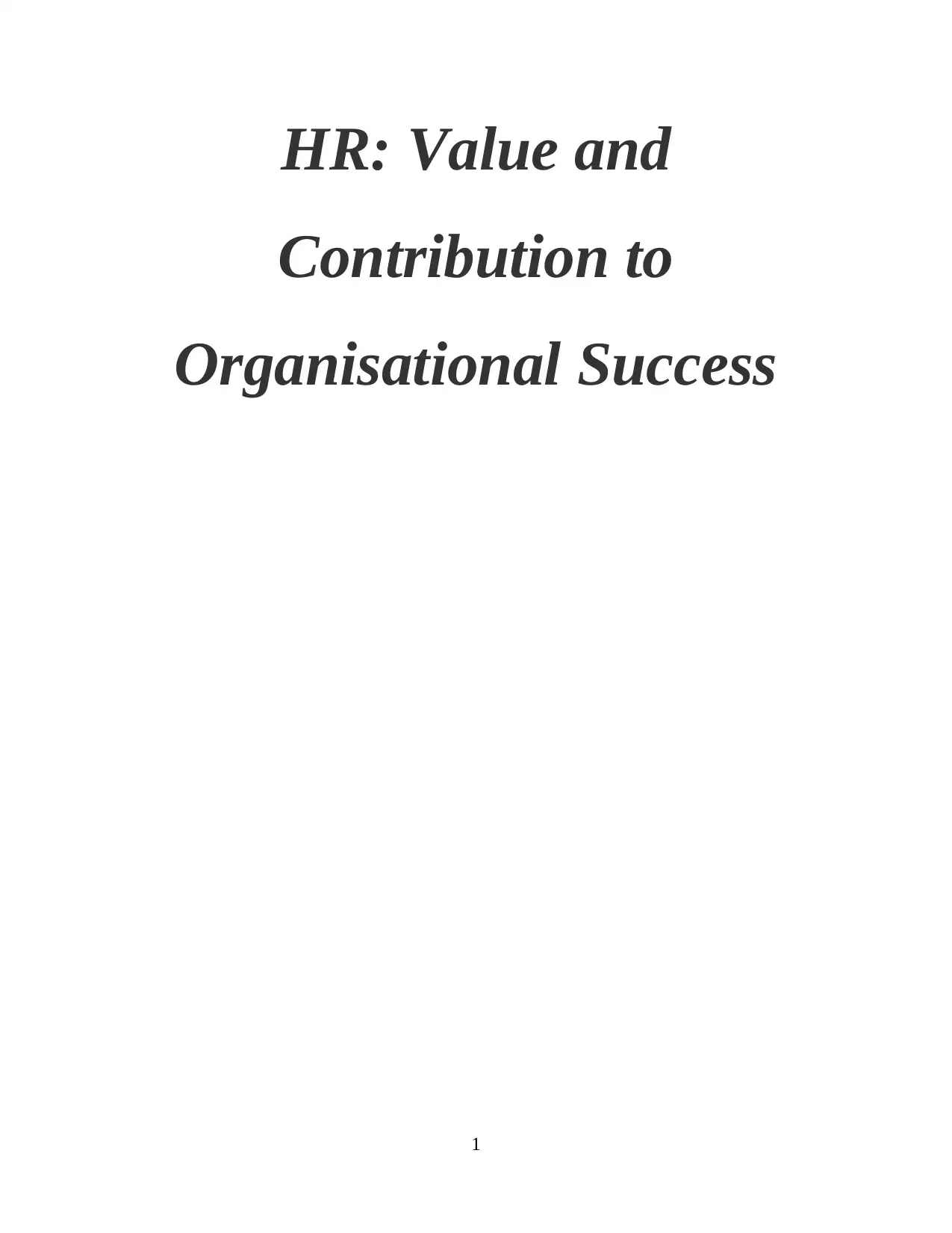
HR: Value and
Contribution to
Organisational Success
1
Contribution to
Organisational Success
1
Paraphrase This Document
Need a fresh take? Get an instant paraphrase of this document with our AI Paraphraser
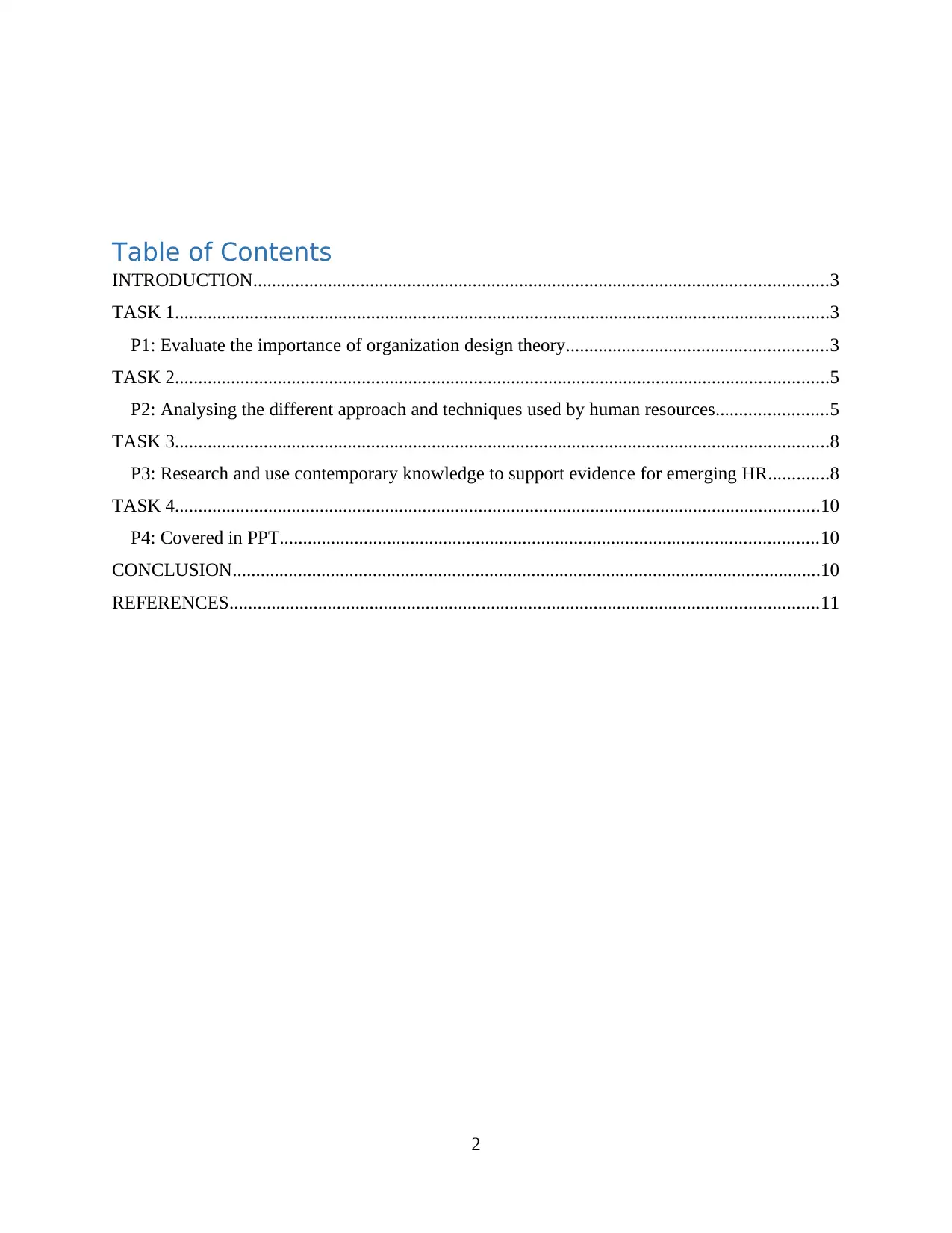
Table of Contents
INTRODUCTION...........................................................................................................................3
TASK 1............................................................................................................................................3
P1: Evaluate the importance of organization design theory........................................................3
TASK 2............................................................................................................................................5
P2: Analysing the different approach and techniques used by human resources........................5
TASK 3............................................................................................................................................8
P3: Research and use contemporary knowledge to support evidence for emerging HR.............8
TASK 4..........................................................................................................................................10
P4: Covered in PPT...................................................................................................................10
CONCLUSION..............................................................................................................................10
REFERENCES..............................................................................................................................11
2
INTRODUCTION...........................................................................................................................3
TASK 1............................................................................................................................................3
P1: Evaluate the importance of organization design theory........................................................3
TASK 2............................................................................................................................................5
P2: Analysing the different approach and techniques used by human resources........................5
TASK 3............................................................................................................................................8
P3: Research and use contemporary knowledge to support evidence for emerging HR.............8
TASK 4..........................................................................................................................................10
P4: Covered in PPT...................................................................................................................10
CONCLUSION..............................................................................................................................10
REFERENCES..............................................................................................................................11
2
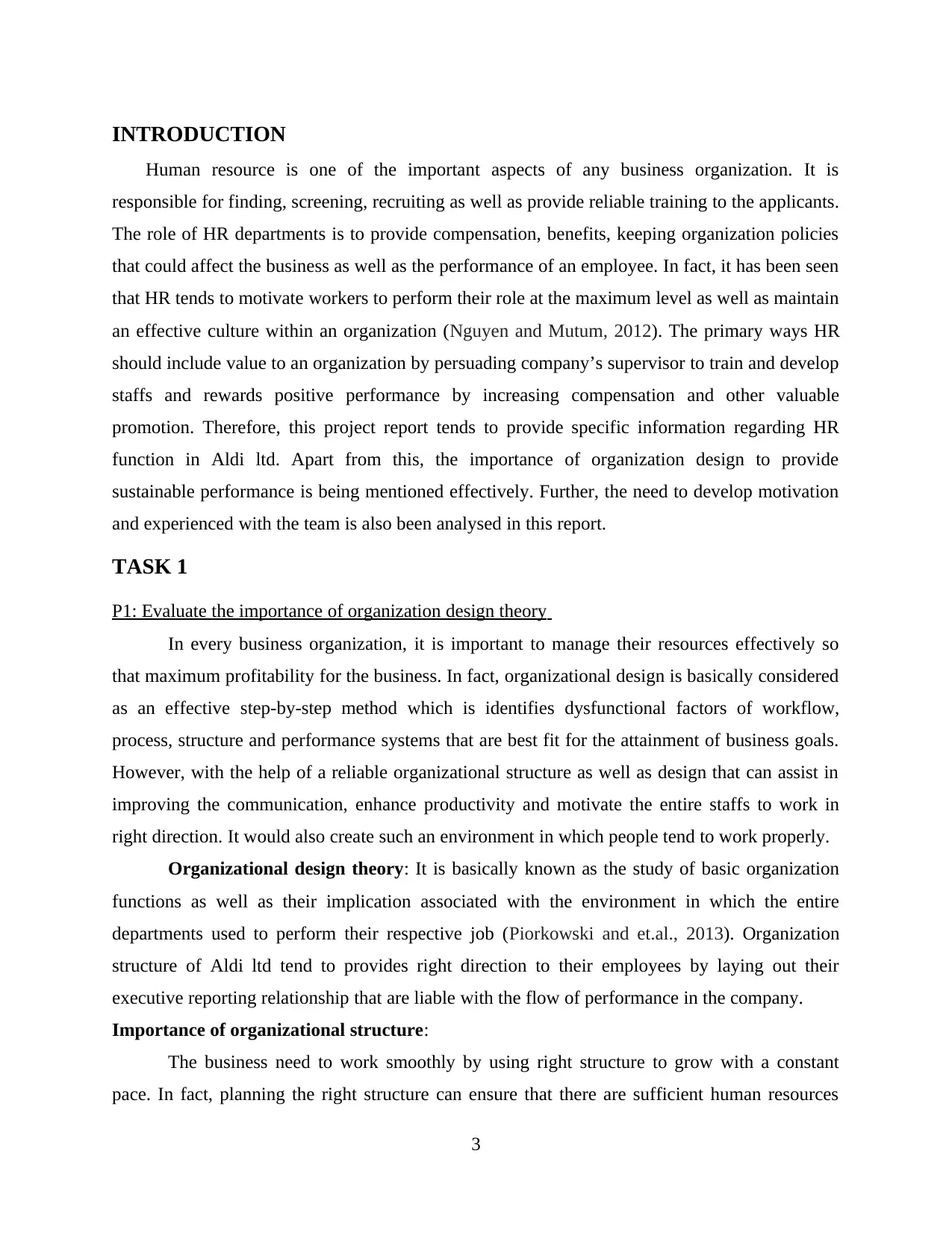
INTRODUCTION
Human resource is one of the important aspects of any business organization. It is
responsible for finding, screening, recruiting as well as provide reliable training to the applicants.
The role of HR departments is to provide compensation, benefits, keeping organization policies
that could affect the business as well as the performance of an employee. In fact, it has been seen
that HR tends to motivate workers to perform their role at the maximum level as well as maintain
an effective culture within an organization (Nguyen and Mutum, 2012). The primary ways HR
should include value to an organization by persuading company’s supervisor to train and develop
staffs and rewards positive performance by increasing compensation and other valuable
promotion. Therefore, this project report tends to provide specific information regarding HR
function in Aldi ltd. Apart from this, the importance of organization design to provide
sustainable performance is being mentioned effectively. Further, the need to develop motivation
and experienced with the team is also been analysed in this report.
TASK 1
P1: Evaluate the importance of organization design theory
In every business organization, it is important to manage their resources effectively so
that maximum profitability for the business. In fact, organizational design is basically considered
as an effective step-by-step method which is identifies dysfunctional factors of workflow,
process, structure and performance systems that are best fit for the attainment of business goals.
However, with the help of a reliable organizational structure as well as design that can assist in
improving the communication, enhance productivity and motivate the entire staffs to work in
right direction. It would also create such an environment in which people tend to work properly.
Organizational design theory: It is basically known as the study of basic organization
functions as well as their implication associated with the environment in which the entire
departments used to perform their respective job (Piorkowski and et.al., 2013). Organization
structure of Aldi ltd tend to provides right direction to their employees by laying out their
executive reporting relationship that are liable with the flow of performance in the company.
Importance of organizational structure:
The business need to work smoothly by using right structure to grow with a constant
pace. In fact, planning the right structure can ensure that there are sufficient human resources
3
Human resource is one of the important aspects of any business organization. It is
responsible for finding, screening, recruiting as well as provide reliable training to the applicants.
The role of HR departments is to provide compensation, benefits, keeping organization policies
that could affect the business as well as the performance of an employee. In fact, it has been seen
that HR tends to motivate workers to perform their role at the maximum level as well as maintain
an effective culture within an organization (Nguyen and Mutum, 2012). The primary ways HR
should include value to an organization by persuading company’s supervisor to train and develop
staffs and rewards positive performance by increasing compensation and other valuable
promotion. Therefore, this project report tends to provide specific information regarding HR
function in Aldi ltd. Apart from this, the importance of organization design to provide
sustainable performance is being mentioned effectively. Further, the need to develop motivation
and experienced with the team is also been analysed in this report.
TASK 1
P1: Evaluate the importance of organization design theory
In every business organization, it is important to manage their resources effectively so
that maximum profitability for the business. In fact, organizational design is basically considered
as an effective step-by-step method which is identifies dysfunctional factors of workflow,
process, structure and performance systems that are best fit for the attainment of business goals.
However, with the help of a reliable organizational structure as well as design that can assist in
improving the communication, enhance productivity and motivate the entire staffs to work in
right direction. It would also create such an environment in which people tend to work properly.
Organizational design theory: It is basically known as the study of basic organization
functions as well as their implication associated with the environment in which the entire
departments used to perform their respective job (Piorkowski and et.al., 2013). Organization
structure of Aldi ltd tend to provides right direction to their employees by laying out their
executive reporting relationship that are liable with the flow of performance in the company.
Importance of organizational structure:
The business need to work smoothly by using right structure to grow with a constant
pace. In fact, planning the right structure can ensure that there are sufficient human resources
3
⊘ This is a preview!⊘
Do you want full access?
Subscribe today to unlock all pages.

Trusted by 1+ million students worldwide

along with the right skills to attain the specific goal of an organization. Some key importances
are:
Increase growth and expansion: The Aldi Company need to make use of their resources
in best and suitable manner so that chances of growth would also remain at high level. It
can only be possible by placing right employees at the right positions.
Efficient task completion: In order to become successful, the company need to prepare a
well-organized structure that can facilitate the overall accomplishment of the projects. It
would be primary responsibility of the managers to identify the human resources
availability at the right time.
Clarifies responsible and power: Another importance of using organizational structure
is to provide delegation of authority to each manager. It will assist them to avoid
confusion regarding the powers and duty (Kokt and Ramarumo, 2015).
Avoid duplication of work: The organization tends to avoid coping of work as well as
duplication in the roles and responsibility between their staffs and employees. This will
helps to assign specific job to the skilled person.
Traditional structure: It has been seen that traditional structure tends to represent the
overall organizational structure in the hierarchical. It means the power flow vertically to upwards
and employees are departmentalized. However, the arrangement of people within Aldi is relies
upon the size, departments and departments heads. Through focusing the quality, the
management always looks to work in a partnership along with their staffs to produce more
relevant outcome for the organization.
Simple structure: It is known as a basic organizational design framework with the low
departments, less work specialization and centralized authority. In fact, this type of structure is
generally considered as operating system that is used by most small business organization in
order to take centralized decision (Pemsel and Wiewiora, 2013).
Functional structure: It is one of the most common types of organization structure. In
this particular structure, the business makes a group employee as per their specialized set of roles
and ability to handle the work. These are categories into some major functions of an organization
such as IT, finance, marketing and production. For example, Virgin mobiles are having
functional structure.
4
are:
Increase growth and expansion: The Aldi Company need to make use of their resources
in best and suitable manner so that chances of growth would also remain at high level. It
can only be possible by placing right employees at the right positions.
Efficient task completion: In order to become successful, the company need to prepare a
well-organized structure that can facilitate the overall accomplishment of the projects. It
would be primary responsibility of the managers to identify the human resources
availability at the right time.
Clarifies responsible and power: Another importance of using organizational structure
is to provide delegation of authority to each manager. It will assist them to avoid
confusion regarding the powers and duty (Kokt and Ramarumo, 2015).
Avoid duplication of work: The organization tends to avoid coping of work as well as
duplication in the roles and responsibility between their staffs and employees. This will
helps to assign specific job to the skilled person.
Traditional structure: It has been seen that traditional structure tends to represent the
overall organizational structure in the hierarchical. It means the power flow vertically to upwards
and employees are departmentalized. However, the arrangement of people within Aldi is relies
upon the size, departments and departments heads. Through focusing the quality, the
management always looks to work in a partnership along with their staffs to produce more
relevant outcome for the organization.
Simple structure: It is known as a basic organizational design framework with the low
departments, less work specialization and centralized authority. In fact, this type of structure is
generally considered as operating system that is used by most small business organization in
order to take centralized decision (Pemsel and Wiewiora, 2013).
Functional structure: It is one of the most common types of organization structure. In
this particular structure, the business makes a group employee as per their specialized set of roles
and ability to handle the work. These are categories into some major functions of an organization
such as IT, finance, marketing and production. For example, Virgin mobiles are having
functional structure.
4
Paraphrase This Document
Need a fresh take? Get an instant paraphrase of this document with our AI Paraphraser
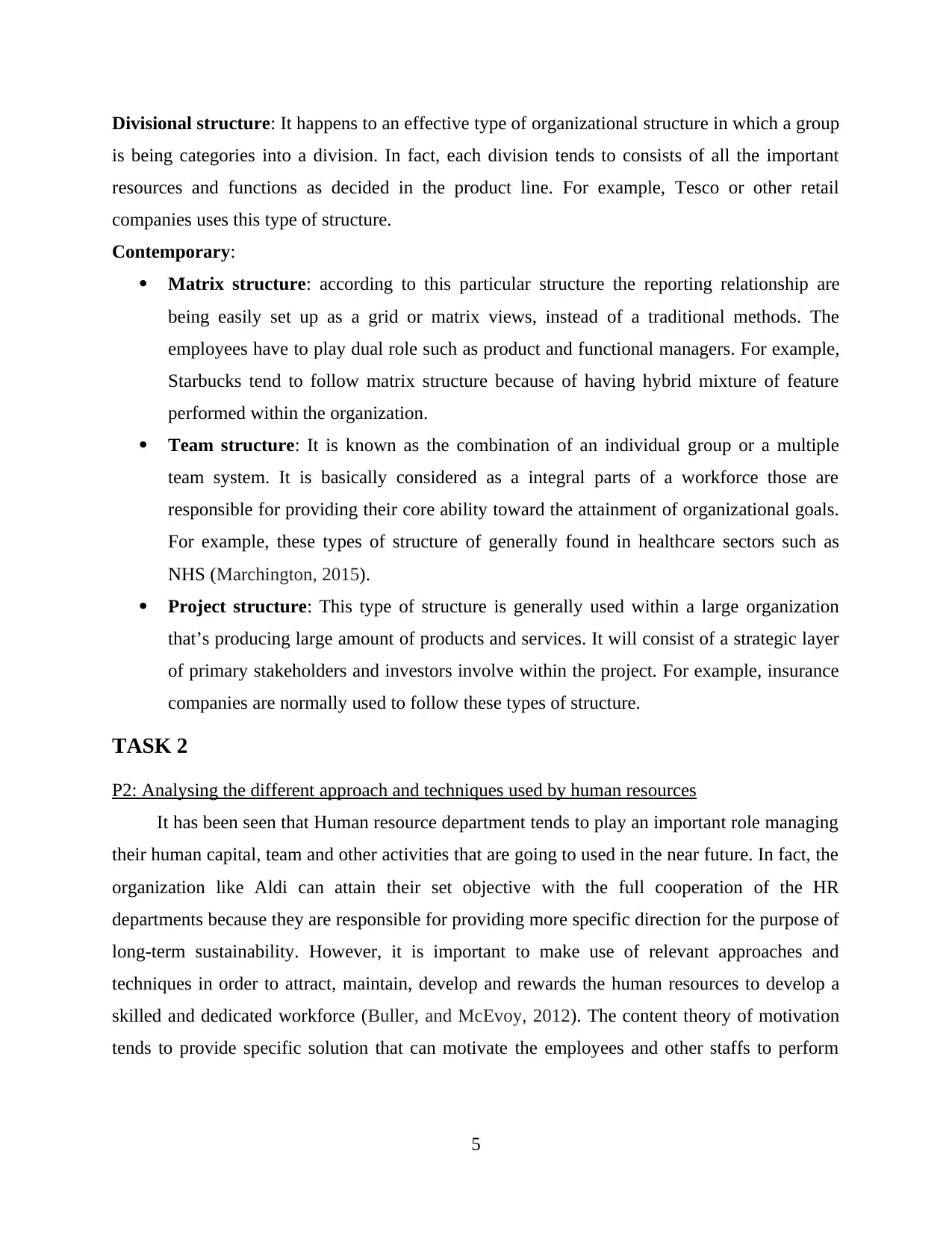
Divisional structure: It happens to an effective type of organizational structure in which a group
is being categories into a division. In fact, each division tends to consists of all the important
resources and functions as decided in the product line. For example, Tesco or other retail
companies uses this type of structure.
Contemporary:
Matrix structure: according to this particular structure the reporting relationship are
being easily set up as a grid or matrix views, instead of a traditional methods. The
employees have to play dual role such as product and functional managers. For example,
Starbucks tend to follow matrix structure because of having hybrid mixture of feature
performed within the organization.
Team structure: It is known as the combination of an individual group or a multiple
team system. It is basically considered as a integral parts of a workforce those are
responsible for providing their core ability toward the attainment of organizational goals.
For example, these types of structure of generally found in healthcare sectors such as
NHS (Marchington, 2015).
Project structure: This type of structure is generally used within a large organization
that’s producing large amount of products and services. It will consist of a strategic layer
of primary stakeholders and investors involve within the project. For example, insurance
companies are normally used to follow these types of structure.
TASK 2
P2: Analysing the different approach and techniques used by human resources
It has been seen that Human resource department tends to play an important role managing
their human capital, team and other activities that are going to used in the near future. In fact, the
organization like Aldi can attain their set objective with the full cooperation of the HR
departments because they are responsible for providing more specific direction for the purpose of
long-term sustainability. However, it is important to make use of relevant approaches and
techniques in order to attract, maintain, develop and rewards the human resources to develop a
skilled and dedicated workforce (Buller, and McEvoy, 2012). The content theory of motivation
tends to provide specific solution that can motivate the employees and other staffs to perform
5
is being categories into a division. In fact, each division tends to consists of all the important
resources and functions as decided in the product line. For example, Tesco or other retail
companies uses this type of structure.
Contemporary:
Matrix structure: according to this particular structure the reporting relationship are
being easily set up as a grid or matrix views, instead of a traditional methods. The
employees have to play dual role such as product and functional managers. For example,
Starbucks tend to follow matrix structure because of having hybrid mixture of feature
performed within the organization.
Team structure: It is known as the combination of an individual group or a multiple
team system. It is basically considered as a integral parts of a workforce those are
responsible for providing their core ability toward the attainment of organizational goals.
For example, these types of structure of generally found in healthcare sectors such as
NHS (Marchington, 2015).
Project structure: This type of structure is generally used within a large organization
that’s producing large amount of products and services. It will consist of a strategic layer
of primary stakeholders and investors involve within the project. For example, insurance
companies are normally used to follow these types of structure.
TASK 2
P2: Analysing the different approach and techniques used by human resources
It has been seen that Human resource department tends to play an important role managing
their human capital, team and other activities that are going to used in the near future. In fact, the
organization like Aldi can attain their set objective with the full cooperation of the HR
departments because they are responsible for providing more specific direction for the purpose of
long-term sustainability. However, it is important to make use of relevant approaches and
techniques in order to attract, maintain, develop and rewards the human resources to develop a
skilled and dedicated workforce (Buller, and McEvoy, 2012). The content theory of motivation
tends to provide specific solution that can motivate the employees and other staffs to perform
5
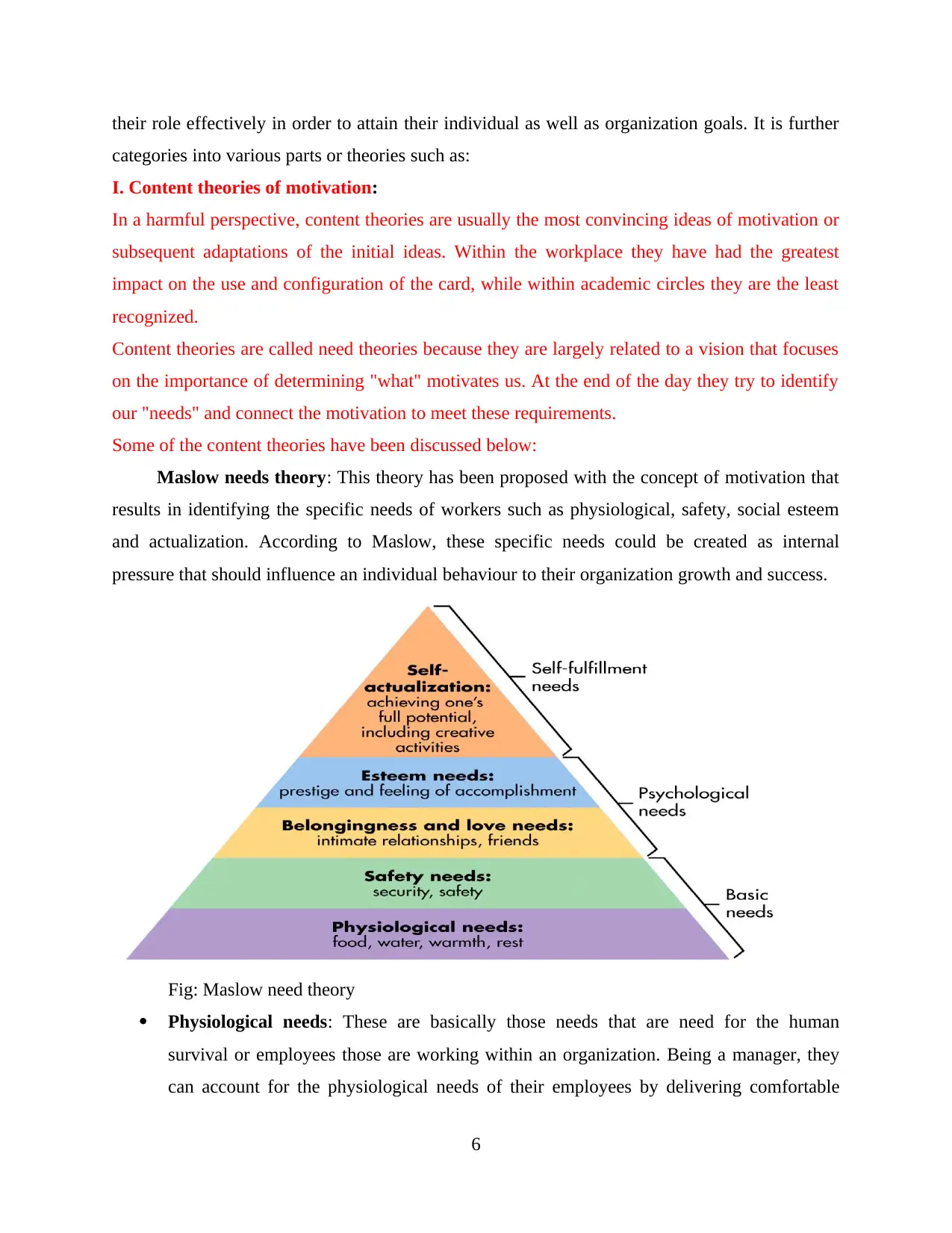
their role effectively in order to attain their individual as well as organization goals. It is further
categories into various parts or theories such as:
I. Content theories of motivation:
In a harmful perspective, content theories are usually the most convincing ideas of motivation or
subsequent adaptations of the initial ideas. Within the workplace they have had the greatest
impact on the use and configuration of the card, while within academic circles they are the least
recognized.
Content theories are called need theories because they are largely related to a vision that focuses
on the importance of determining "what" motivates us. At the end of the day they try to identify
our "needs" and connect the motivation to meet these requirements.
Some of the content theories have been discussed below:
Maslow needs theory: This theory has been proposed with the concept of motivation that
results in identifying the specific needs of workers such as physiological, safety, social esteem
and actualization. According to Maslow, these specific needs could be created as internal
pressure that should influence an individual behaviour to their organization growth and success.
Fig: Maslow need theory
Physiological needs: These are basically those needs that are need for the human
survival or employees those are working within an organization. Being a manager, they
can account for the physiological needs of their employees by delivering comfortable
6
categories into various parts or theories such as:
I. Content theories of motivation:
In a harmful perspective, content theories are usually the most convincing ideas of motivation or
subsequent adaptations of the initial ideas. Within the workplace they have had the greatest
impact on the use and configuration of the card, while within academic circles they are the least
recognized.
Content theories are called need theories because they are largely related to a vision that focuses
on the importance of determining "what" motivates us. At the end of the day they try to identify
our "needs" and connect the motivation to meet these requirements.
Some of the content theories have been discussed below:
Maslow needs theory: This theory has been proposed with the concept of motivation that
results in identifying the specific needs of workers such as physiological, safety, social esteem
and actualization. According to Maslow, these specific needs could be created as internal
pressure that should influence an individual behaviour to their organization growth and success.
Fig: Maslow need theory
Physiological needs: These are basically those needs that are need for the human
survival or employees those are working within an organization. Being a manager, they
can account for the physiological needs of their employees by delivering comfortable
6
⊘ This is a preview!⊘
Do you want full access?
Subscribe today to unlock all pages.

Trusted by 1+ million students worldwide
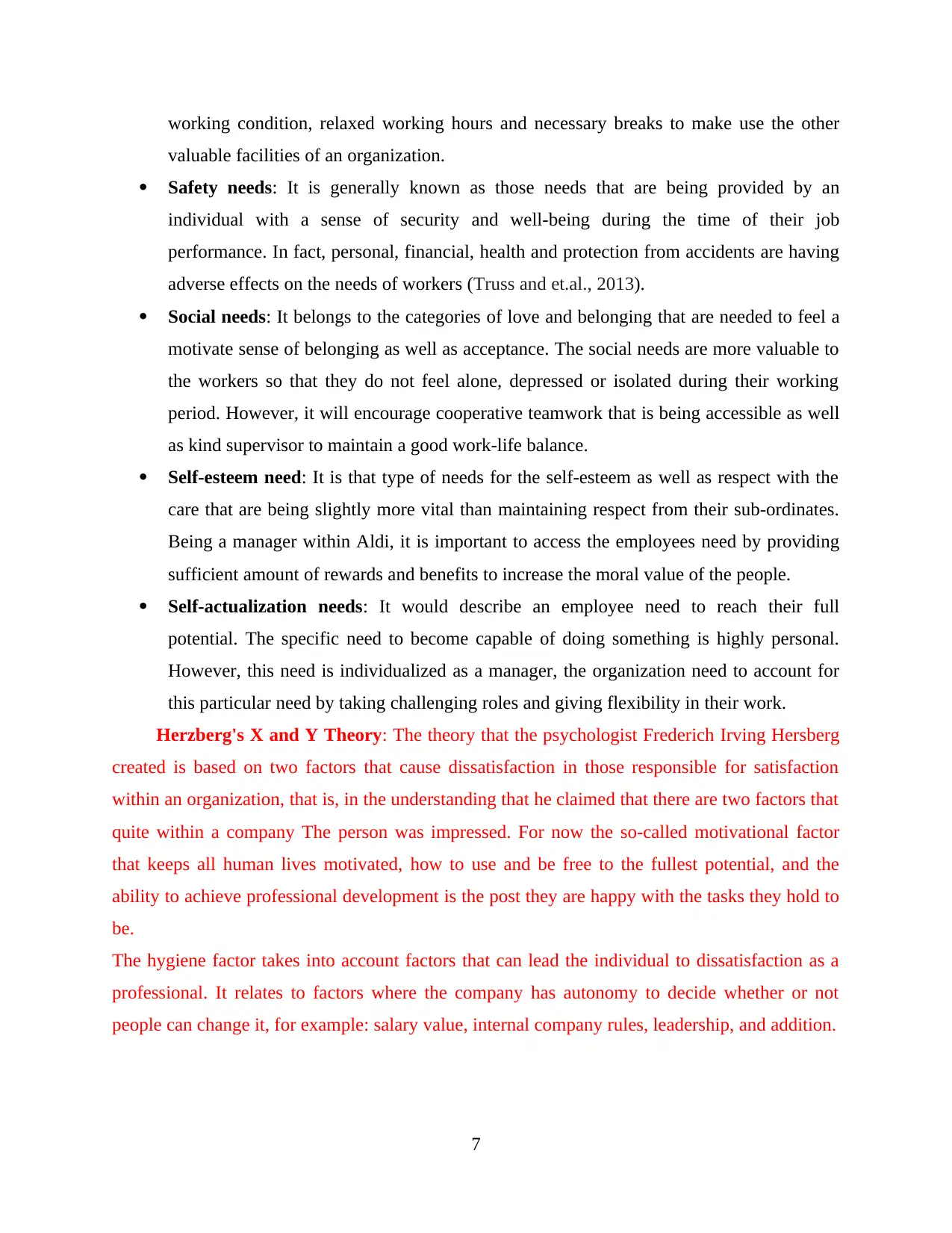
working condition, relaxed working hours and necessary breaks to make use the other
valuable facilities of an organization.
Safety needs: It is generally known as those needs that are being provided by an
individual with a sense of security and well-being during the time of their job
performance. In fact, personal, financial, health and protection from accidents are having
adverse effects on the needs of workers (Truss and et.al., 2013).
Social needs: It belongs to the categories of love and belonging that are needed to feel a
motivate sense of belonging as well as acceptance. The social needs are more valuable to
the workers so that they do not feel alone, depressed or isolated during their working
period. However, it will encourage cooperative teamwork that is being accessible as well
as kind supervisor to maintain a good work-life balance.
Self-esteem need: It is that type of needs for the self-esteem as well as respect with the
care that are being slightly more vital than maintaining respect from their sub-ordinates.
Being a manager within Aldi, it is important to access the employees need by providing
sufficient amount of rewards and benefits to increase the moral value of the people.
Self-actualization needs: It would describe an employee need to reach their full
potential. The specific need to become capable of doing something is highly personal.
However, this need is individualized as a manager, the organization need to account for
this particular need by taking challenging roles and giving flexibility in their work.
Herzberg's X and Y Theory: The theory that the psychologist Frederich Irving Hersberg
created is based on two factors that cause dissatisfaction in those responsible for satisfaction
within an organization, that is, in the understanding that he claimed that there are two factors that
quite within a company The person was impressed. For now the so-called motivational factor
that keeps all human lives motivated, how to use and be free to the fullest potential, and the
ability to achieve professional development is the post they are happy with the tasks they hold to
be.
The hygiene factor takes into account factors that can lead the individual to dissatisfaction as a
professional. It relates to factors where the company has autonomy to decide whether or not
people can change it, for example: salary value, internal company rules, leadership, and addition.
7
valuable facilities of an organization.
Safety needs: It is generally known as those needs that are being provided by an
individual with a sense of security and well-being during the time of their job
performance. In fact, personal, financial, health and protection from accidents are having
adverse effects on the needs of workers (Truss and et.al., 2013).
Social needs: It belongs to the categories of love and belonging that are needed to feel a
motivate sense of belonging as well as acceptance. The social needs are more valuable to
the workers so that they do not feel alone, depressed or isolated during their working
period. However, it will encourage cooperative teamwork that is being accessible as well
as kind supervisor to maintain a good work-life balance.
Self-esteem need: It is that type of needs for the self-esteem as well as respect with the
care that are being slightly more vital than maintaining respect from their sub-ordinates.
Being a manager within Aldi, it is important to access the employees need by providing
sufficient amount of rewards and benefits to increase the moral value of the people.
Self-actualization needs: It would describe an employee need to reach their full
potential. The specific need to become capable of doing something is highly personal.
However, this need is individualized as a manager, the organization need to account for
this particular need by taking challenging roles and giving flexibility in their work.
Herzberg's X and Y Theory: The theory that the psychologist Frederich Irving Hersberg
created is based on two factors that cause dissatisfaction in those responsible for satisfaction
within an organization, that is, in the understanding that he claimed that there are two factors that
quite within a company The person was impressed. For now the so-called motivational factor
that keeps all human lives motivated, how to use and be free to the fullest potential, and the
ability to achieve professional development is the post they are happy with the tasks they hold to
be.
The hygiene factor takes into account factors that can lead the individual to dissatisfaction as a
professional. It relates to factors where the company has autonomy to decide whether or not
people can change it, for example: salary value, internal company rules, leadership, and addition.
7
Paraphrase This Document
Need a fresh take? Get an instant paraphrase of this document with our AI Paraphraser

II. Process theory of motivation:
This theory is a system of ideas that tends to explain an organization changes and
development they are taking place with the motive to attain a desire goals. These are basically
contrasted with variance a theory that is related to concept of motivation (Neves and
Eisenberger, 2012). These theories tends to analyse the individual needs would affect the
behaviour in order to attain a gaol associated with that particular needs. However, it tends to
further categories into various theories such as:
Three need theory: This theory is being given by a great psychologist David McClelland.
This motivational model attempts to determine the needs for attaining, power and affiliation that
could affect the actions of an individual from a managerial level.
Fig: Three need theory
Achievement: It is basically related to a set of challenging goal that is being followed by
an organization. However, the employees usually take risk to reach their goal as well as
like to receive regular feedback on their entire growth and achievements.
Affiliation: The employees want to be associated with the group as well as often go
along with the rest of the group members those are involve during a project. The
organization need to make favour with the collaborative efforts of the entire team
members to face the tough competition. These types of employees do not want to take
high risk in their working period.
8
This theory is a system of ideas that tends to explain an organization changes and
development they are taking place with the motive to attain a desire goals. These are basically
contrasted with variance a theory that is related to concept of motivation (Neves and
Eisenberger, 2012). These theories tends to analyse the individual needs would affect the
behaviour in order to attain a gaol associated with that particular needs. However, it tends to
further categories into various theories such as:
Three need theory: This theory is being given by a great psychologist David McClelland.
This motivational model attempts to determine the needs for attaining, power and affiliation that
could affect the actions of an individual from a managerial level.
Fig: Three need theory
Achievement: It is basically related to a set of challenging goal that is being followed by
an organization. However, the employees usually take risk to reach their goal as well as
like to receive regular feedback on their entire growth and achievements.
Affiliation: The employees want to be associated with the group as well as often go
along with the rest of the group members those are involve during a project. The
organization need to make favour with the collaborative efforts of the entire team
members to face the tough competition. These types of employees do not want to take
high risk in their working period.
8
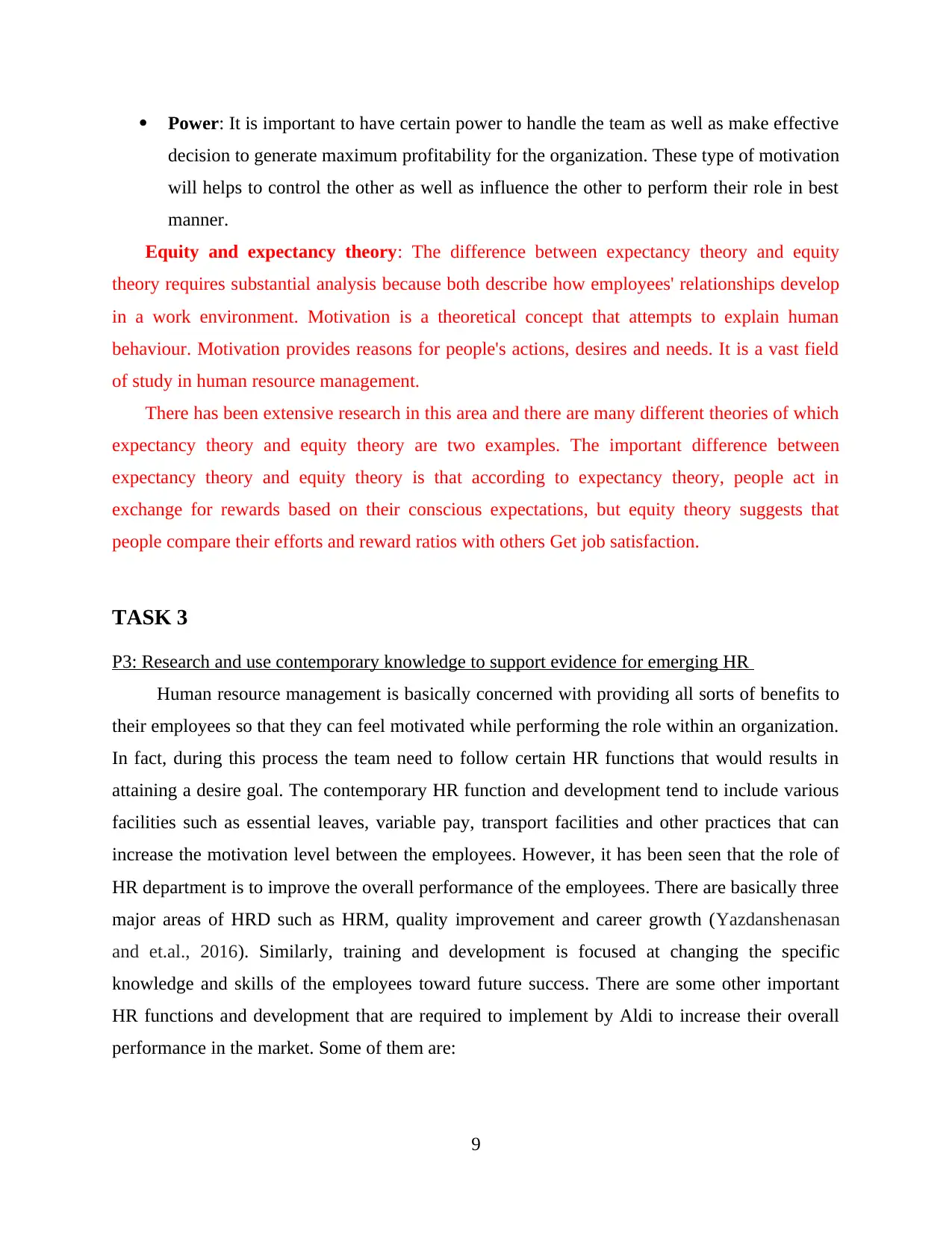
Power: It is important to have certain power to handle the team as well as make effective
decision to generate maximum profitability for the organization. These type of motivation
will helps to control the other as well as influence the other to perform their role in best
manner.
Equity and expectancy theory: The difference between expectancy theory and equity
theory requires substantial analysis because both describe how employees' relationships develop
in a work environment. Motivation is a theoretical concept that attempts to explain human
behaviour. Motivation provides reasons for people's actions, desires and needs. It is a vast field
of study in human resource management.
There has been extensive research in this area and there are many different theories of which
expectancy theory and equity theory are two examples. The important difference between
expectancy theory and equity theory is that according to expectancy theory, people act in
exchange for rewards based on their conscious expectations, but equity theory suggests that
people compare their efforts and reward ratios with others Get job satisfaction.
TASK 3
P3: Research and use contemporary knowledge to support evidence for emerging HR
Human resource management is basically concerned with providing all sorts of benefits to
their employees so that they can feel motivated while performing the role within an organization.
In fact, during this process the team need to follow certain HR functions that would results in
attaining a desire goal. The contemporary HR function and development tend to include various
facilities such as essential leaves, variable pay, transport facilities and other practices that can
increase the motivation level between the employees. However, it has been seen that the role of
HR department is to improve the overall performance of the employees. There are basically three
major areas of HRD such as HRM, quality improvement and career growth (Yazdanshenasan
and et.al., 2016). Similarly, training and development is focused at changing the specific
knowledge and skills of the employees toward future success. There are some other important
HR functions and development that are required to implement by Aldi to increase their overall
performance in the market. Some of them are:
9
decision to generate maximum profitability for the organization. These type of motivation
will helps to control the other as well as influence the other to perform their role in best
manner.
Equity and expectancy theory: The difference between expectancy theory and equity
theory requires substantial analysis because both describe how employees' relationships develop
in a work environment. Motivation is a theoretical concept that attempts to explain human
behaviour. Motivation provides reasons for people's actions, desires and needs. It is a vast field
of study in human resource management.
There has been extensive research in this area and there are many different theories of which
expectancy theory and equity theory are two examples. The important difference between
expectancy theory and equity theory is that according to expectancy theory, people act in
exchange for rewards based on their conscious expectations, but equity theory suggests that
people compare their efforts and reward ratios with others Get job satisfaction.
TASK 3
P3: Research and use contemporary knowledge to support evidence for emerging HR
Human resource management is basically concerned with providing all sorts of benefits to
their employees so that they can feel motivated while performing the role within an organization.
In fact, during this process the team need to follow certain HR functions that would results in
attaining a desire goal. The contemporary HR function and development tend to include various
facilities such as essential leaves, variable pay, transport facilities and other practices that can
increase the motivation level between the employees. However, it has been seen that the role of
HR department is to improve the overall performance of the employees. There are basically three
major areas of HRD such as HRM, quality improvement and career growth (Yazdanshenasan
and et.al., 2016). Similarly, training and development is focused at changing the specific
knowledge and skills of the employees toward future success. There are some other important
HR functions and development that are required to implement by Aldi to increase their overall
performance in the market. Some of them are:
9
⊘ This is a preview!⊘
Do you want full access?
Subscribe today to unlock all pages.

Trusted by 1+ million students worldwide
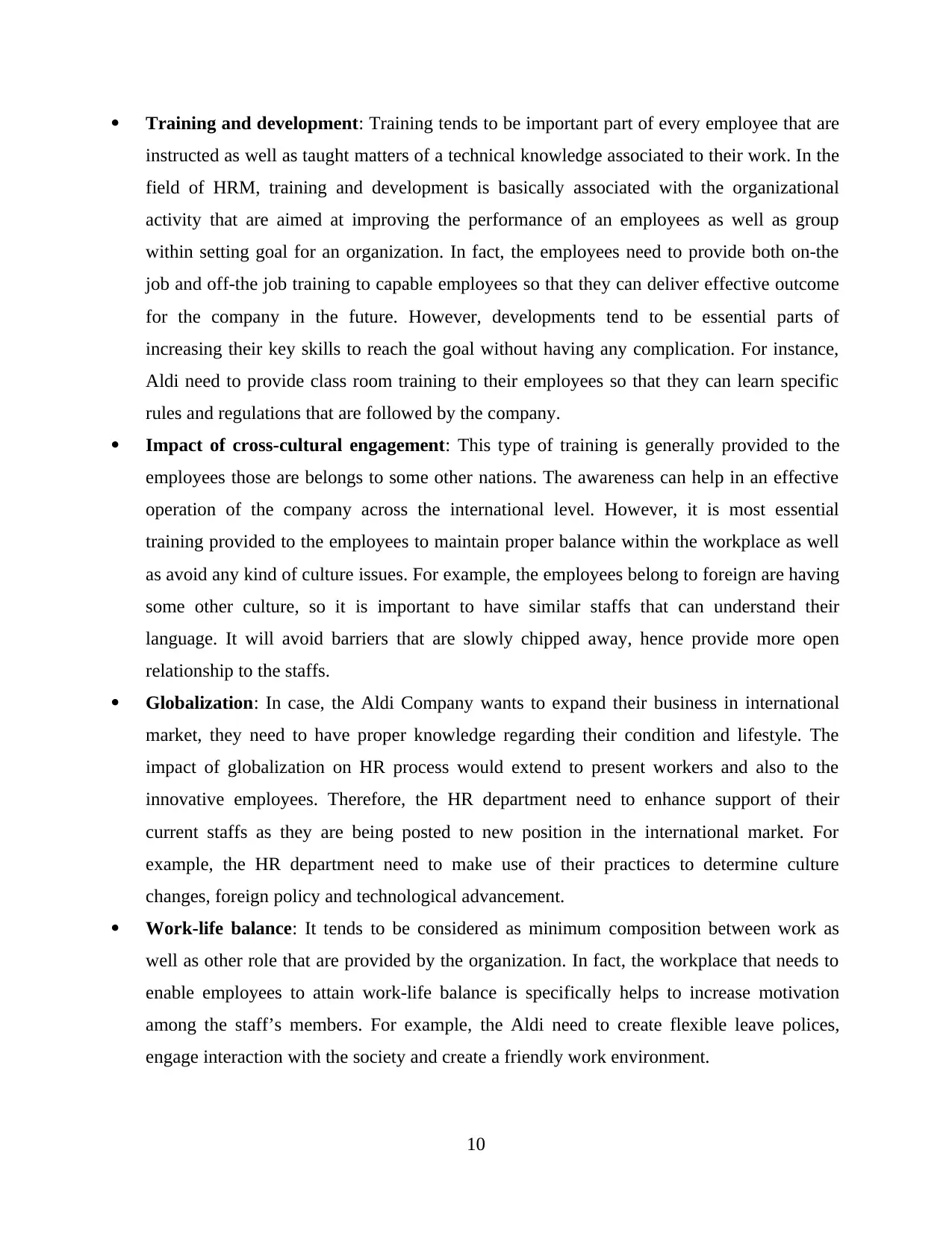
Training and development: Training tends to be important part of every employee that are
instructed as well as taught matters of a technical knowledge associated to their work. In the
field of HRM, training and development is basically associated with the organizational
activity that are aimed at improving the performance of an employees as well as group
within setting goal for an organization. In fact, the employees need to provide both on-the
job and off-the job training to capable employees so that they can deliver effective outcome
for the company in the future. However, developments tend to be essential parts of
increasing their key skills to reach the goal without having any complication. For instance,
Aldi need to provide class room training to their employees so that they can learn specific
rules and regulations that are followed by the company.
Impact of cross-cultural engagement: This type of training is generally provided to the
employees those are belongs to some other nations. The awareness can help in an effective
operation of the company across the international level. However, it is most essential
training provided to the employees to maintain proper balance within the workplace as well
as avoid any kind of culture issues. For example, the employees belong to foreign are having
some other culture, so it is important to have similar staffs that can understand their
language. It will avoid barriers that are slowly chipped away, hence provide more open
relationship to the staffs.
Globalization: In case, the Aldi Company wants to expand their business in international
market, they need to have proper knowledge regarding their condition and lifestyle. The
impact of globalization on HR process would extend to present workers and also to the
innovative employees. Therefore, the HR department need to enhance support of their
current staffs as they are being posted to new position in the international market. For
example, the HR department need to make use of their practices to determine culture
changes, foreign policy and technological advancement.
Work-life balance: It tends to be considered as minimum composition between work as
well as other role that are provided by the organization. In fact, the workplace that needs to
enable employees to attain work-life balance is specifically helps to increase motivation
among the staff’s members. For example, the Aldi need to create flexible leave polices,
engage interaction with the society and create a friendly work environment.
10
instructed as well as taught matters of a technical knowledge associated to their work. In the
field of HRM, training and development is basically associated with the organizational
activity that are aimed at improving the performance of an employees as well as group
within setting goal for an organization. In fact, the employees need to provide both on-the
job and off-the job training to capable employees so that they can deliver effective outcome
for the company in the future. However, developments tend to be essential parts of
increasing their key skills to reach the goal without having any complication. For instance,
Aldi need to provide class room training to their employees so that they can learn specific
rules and regulations that are followed by the company.
Impact of cross-cultural engagement: This type of training is generally provided to the
employees those are belongs to some other nations. The awareness can help in an effective
operation of the company across the international level. However, it is most essential
training provided to the employees to maintain proper balance within the workplace as well
as avoid any kind of culture issues. For example, the employees belong to foreign are having
some other culture, so it is important to have similar staffs that can understand their
language. It will avoid barriers that are slowly chipped away, hence provide more open
relationship to the staffs.
Globalization: In case, the Aldi Company wants to expand their business in international
market, they need to have proper knowledge regarding their condition and lifestyle. The
impact of globalization on HR process would extend to present workers and also to the
innovative employees. Therefore, the HR department need to enhance support of their
current staffs as they are being posted to new position in the international market. For
example, the HR department need to make use of their practices to determine culture
changes, foreign policy and technological advancement.
Work-life balance: It tends to be considered as minimum composition between work as
well as other role that are provided by the organization. In fact, the workplace that needs to
enable employees to attain work-life balance is specifically helps to increase motivation
among the staff’s members. For example, the Aldi need to create flexible leave polices,
engage interaction with the society and create a friendly work environment.
10
Paraphrase This Document
Need a fresh take? Get an instant paraphrase of this document with our AI Paraphraser
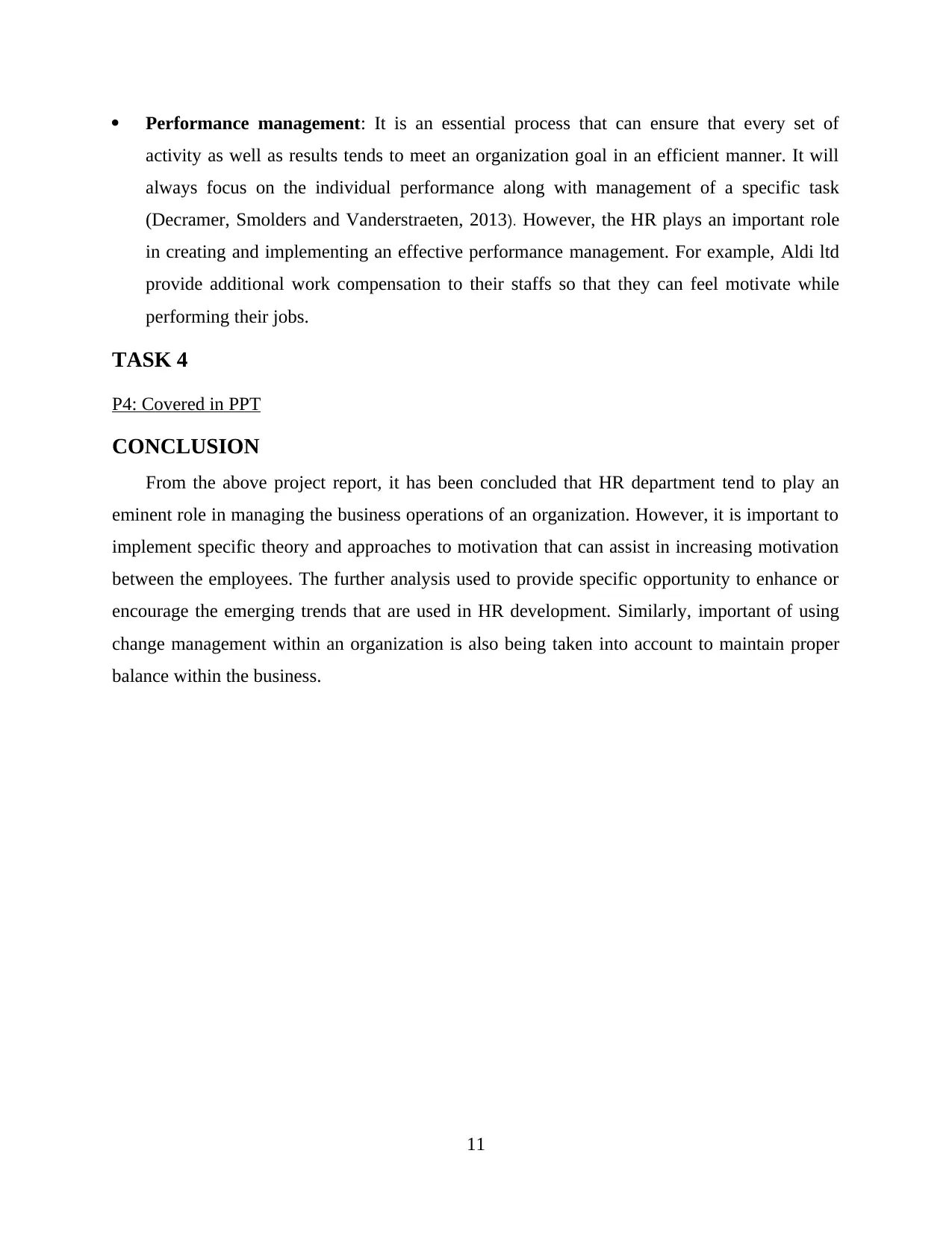
Performance management: It is an essential process that can ensure that every set of
activity as well as results tends to meet an organization goal in an efficient manner. It will
always focus on the individual performance along with management of a specific task
(Decramer, Smolders and Vanderstraeten, 2013). However, the HR plays an important role
in creating and implementing an effective performance management. For example, Aldi ltd
provide additional work compensation to their staffs so that they can feel motivate while
performing their jobs.
TASK 4
P4: Covered in PPT
CONCLUSION
From the above project report, it has been concluded that HR department tend to play an
eminent role in managing the business operations of an organization. However, it is important to
implement specific theory and approaches to motivation that can assist in increasing motivation
between the employees. The further analysis used to provide specific opportunity to enhance or
encourage the emerging trends that are used in HR development. Similarly, important of using
change management within an organization is also being taken into account to maintain proper
balance within the business.
11
activity as well as results tends to meet an organization goal in an efficient manner. It will
always focus on the individual performance along with management of a specific task
(Decramer, Smolders and Vanderstraeten, 2013). However, the HR plays an important role
in creating and implementing an effective performance management. For example, Aldi ltd
provide additional work compensation to their staffs so that they can feel motivate while
performing their jobs.
TASK 4
P4: Covered in PPT
CONCLUSION
From the above project report, it has been concluded that HR department tend to play an
eminent role in managing the business operations of an organization. However, it is important to
implement specific theory and approaches to motivation that can assist in increasing motivation
between the employees. The further analysis used to provide specific opportunity to enhance or
encourage the emerging trends that are used in HR development. Similarly, important of using
change management within an organization is also being taken into account to maintain proper
balance within the business.
11
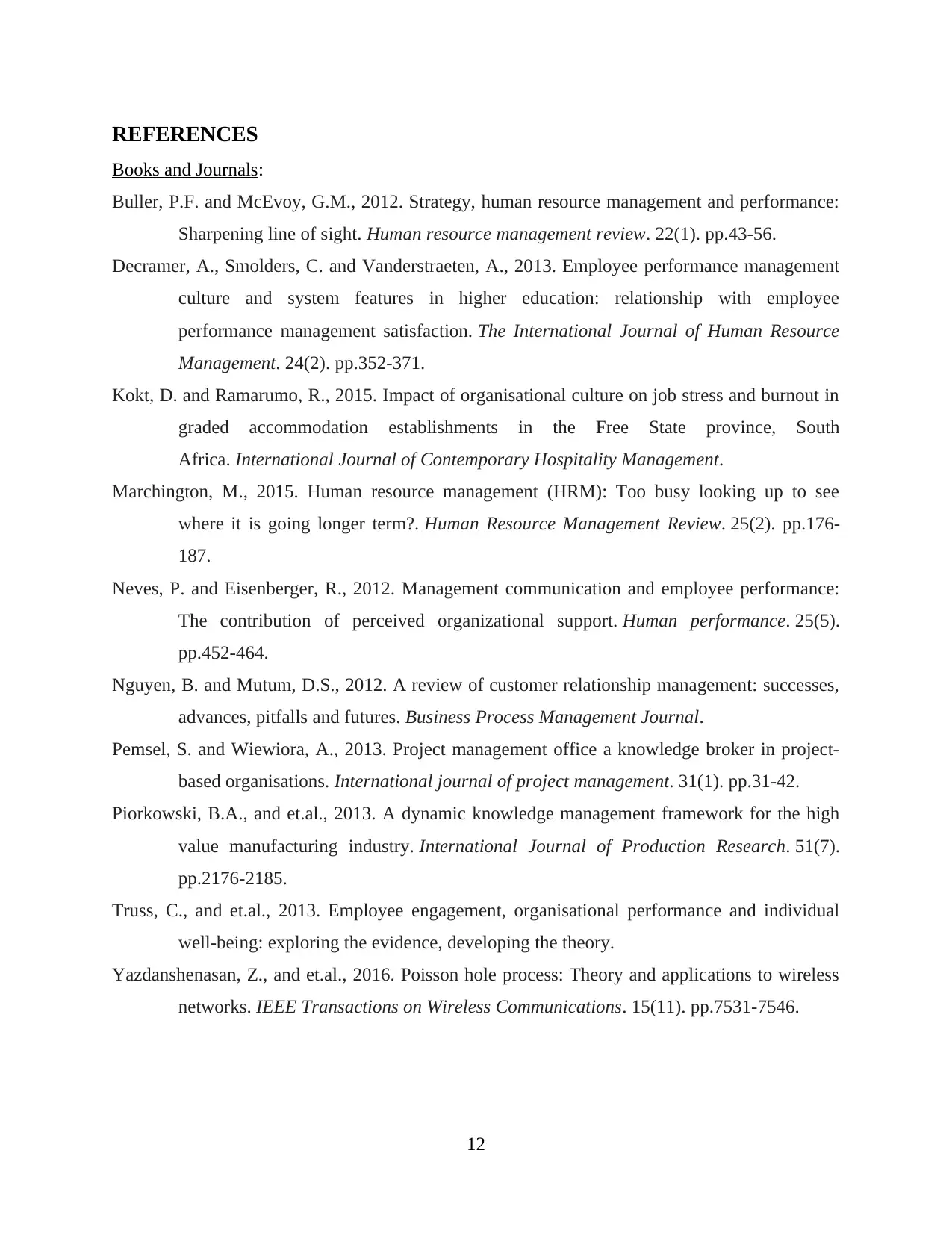
REFERENCES
Books and Journals:
Buller, P.F. and McEvoy, G.M., 2012. Strategy, human resource management and performance:
Sharpening line of sight. Human resource management review. 22(1). pp.43-56.
Decramer, A., Smolders, C. and Vanderstraeten, A., 2013. Employee performance management
culture and system features in higher education: relationship with employee
performance management satisfaction. The International Journal of Human Resource
Management. 24(2). pp.352-371.
Kokt, D. and Ramarumo, R., 2015. Impact of organisational culture on job stress and burnout in
graded accommodation establishments in the Free State province, South
Africa. International Journal of Contemporary Hospitality Management.
Marchington, M., 2015. Human resource management (HRM): Too busy looking up to see
where it is going longer term?. Human Resource Management Review. 25(2). pp.176-
187.
Neves, P. and Eisenberger, R., 2012. Management communication and employee performance:
The contribution of perceived organizational support. Human performance. 25(5).
pp.452-464.
Nguyen, B. and Mutum, D.S., 2012. A review of customer relationship management: successes,
advances, pitfalls and futures. Business Process Management Journal.
Pemsel, S. and Wiewiora, A., 2013. Project management office a knowledge broker in project-
based organisations. International journal of project management. 31(1). pp.31-42.
Piorkowski, B.A., and et.al., 2013. A dynamic knowledge management framework for the high
value manufacturing industry. International Journal of Production Research. 51(7).
pp.2176-2185.
Truss, C., and et.al., 2013. Employee engagement, organisational performance and individual
well-being: exploring the evidence, developing the theory.
Yazdanshenasan, Z., and et.al., 2016. Poisson hole process: Theory and applications to wireless
networks. IEEE Transactions on Wireless Communications. 15(11). pp.7531-7546.
12
Books and Journals:
Buller, P.F. and McEvoy, G.M., 2012. Strategy, human resource management and performance:
Sharpening line of sight. Human resource management review. 22(1). pp.43-56.
Decramer, A., Smolders, C. and Vanderstraeten, A., 2013. Employee performance management
culture and system features in higher education: relationship with employee
performance management satisfaction. The International Journal of Human Resource
Management. 24(2). pp.352-371.
Kokt, D. and Ramarumo, R., 2015. Impact of organisational culture on job stress and burnout in
graded accommodation establishments in the Free State province, South
Africa. International Journal of Contemporary Hospitality Management.
Marchington, M., 2015. Human resource management (HRM): Too busy looking up to see
where it is going longer term?. Human Resource Management Review. 25(2). pp.176-
187.
Neves, P. and Eisenberger, R., 2012. Management communication and employee performance:
The contribution of perceived organizational support. Human performance. 25(5).
pp.452-464.
Nguyen, B. and Mutum, D.S., 2012. A review of customer relationship management: successes,
advances, pitfalls and futures. Business Process Management Journal.
Pemsel, S. and Wiewiora, A., 2013. Project management office a knowledge broker in project-
based organisations. International journal of project management. 31(1). pp.31-42.
Piorkowski, B.A., and et.al., 2013. A dynamic knowledge management framework for the high
value manufacturing industry. International Journal of Production Research. 51(7).
pp.2176-2185.
Truss, C., and et.al., 2013. Employee engagement, organisational performance and individual
well-being: exploring the evidence, developing the theory.
Yazdanshenasan, Z., and et.al., 2016. Poisson hole process: Theory and applications to wireless
networks. IEEE Transactions on Wireless Communications. 15(11). pp.7531-7546.
12
⊘ This is a preview!⊘
Do you want full access?
Subscribe today to unlock all pages.

Trusted by 1+ million students worldwide
1 out of 12
Related Documents
Your All-in-One AI-Powered Toolkit for Academic Success.
+13062052269
info@desklib.com
Available 24*7 on WhatsApp / Email
![[object Object]](/_next/static/media/star-bottom.7253800d.svg)
Unlock your academic potential
Copyright © 2020–2025 A2Z Services. All Rights Reserved. Developed and managed by ZUCOL.




